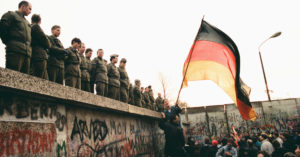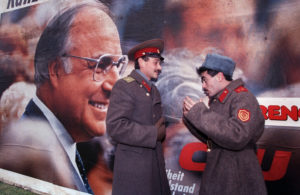The Germans might not be setting their capital on fire, but when King Charles touches down in Berlin this morning, he will do so knowing that he is visiting a country no less divided than its western neighbour. While France is being ripped apart by violent protests over very modern pension reforms, Germany is haunted by much older ghosts.
After two world wars, an aversion to military conflict has long hampered Berlin’s ability to act decisively and shoulder its fair share of responsibility as part of the Western alliance. In the past decade, Germany’s defence budget barely made it across the 1% mark of GDP, never mind the 2% required by Nato. When Russia’s invasion of Ukraine exposed the fallacies of Germany’s unconditional pacifism, it plunged Berlin into an identity crisis. A national rethink was in order and Chancellor Olaf Scholz dramatically declared in February 2022 that a Zeitenwende, a watershed moment, was underway: “the world afterwards will no longer be the same as the world before.” While German aid to Ukraine was initially sluggish and always badly communicated, it is now among its biggest financial and military supporters. Only yesterday, 18 German Leopard 2s arrived in Ukraine.
There are many Germans who can’t and won’t kiss old certainties goodbye. But the two world wars at the root of modern German angst were all-encompassing catastrophes that plunged the entire country into a moral abyss. This trauma is a national one and, since Russia’s invasion, has triggered a lively public debate, leading to a degree of change. Alongside a vastly increased military budget for the German army, Berlin has also just announced that it wants to raise military aid for Ukraine from currently €3 billion to more than €15 billion in the next few years — a clear sign that it is beginning to come around to the idea of contributing to European security on a much greater scale despite its historical inhibitions.
The same cannot be said about another legacy of Germany’s tumultuous 20th century: the fact that it spent much of the latter half as two separate countries. Between 1949 and 1990 two Germanies existed: the Federal Republic in the West and the German Democratic Republic (GDR) in the East. Each found very different ways to move on from the horrors of war and genocide. And unification in 1990 was not enough to foster agreement on Germany’s response to armed conflict, particularly not one that involves Russia.
When East Germany vanished overnight, 16 million people who had been born there became citizens of a country that was in many ways alien to them. Their fellow Germans on the other side of the Berlin Wall may have shared their language and cultural roots, but they had an entirely different understanding of modern Germany’s place in the world.
From West Germany’s very foundation in 1949, its first chancellor Konrad Adenauer’s transatlantic outlook and focus on reconciliation with France laid the groundwork for a thoroughly Western political identity. His American partners supported this process, seeing in West Germany the easternmost outpost of the democratic world, one they wanted to fortify against Soviet influence. As a result of its ringside seat on the fault lines of the Cold War, West Germany became a fully fledged member of Nato in 1955, a mere decade after the end of the most devastating war the world had ever seen. Supreme Allied Commander Dwight D. Eisenhower declared in 1951 that he did “not believe that the German soldier as such has lost his honour” in the Second World War. Adenauer was trusted to rebuild a German army, the Bundeswehr, in the early Fifties.
Adenauer saw no conflict in the fact that he was binding German soldiers to their former Western enemies. He declared in 1955 that Nato’s objectives were “in full harmony with the natural interest of the German nation”. While many Germans, particularly his opponents on the Left, disagreed with him, he pressed ahead, spending over 4% of GDP on defence in almost every year of his tenure, from 1949 to 1963. Bundeswehr pilots learned how to drop American nuclear bombs which were stationed on their soil alongside American nuclear-capable missiles. With male conscription reintroduced in 1956, West German men learnt to fight for and with Nato. Even as defence spending was gradually reduced and a powerful peace movement evolved in West Germany with anti-American strains, the bulk of society remained firmly Western in outlook. Nato was a partner, not the enemy.
It was this outlook that East Germans were expected to share when they joined the Federal Republic in 1990. After all, they had gleefully watched Western television in secret and obsessed over branded American jeans. They had eventually joined mass demonstrations to bring down their socialist system and then voted for parties that had advocated a swift and one-sided unification process. It seemed reasonable to assume that they had shared the pro-Western outlook of their counterparts on the other side of the Iron Curtain all along.
Yet East Germans were not asked to return to something they were once part of, but to blend into a state that had evolved without them. They had served in the National People’s Army, formed in 1956, and were integrated into the Warsaw Pact. Unlike the trust Adenauer had enjoyed from his American Allies, the East German leadership had a rather different relationship with Moscow. During the Prague Spring in 1968, when the Soviets suppressed political reform in Czechoslovakia, East German troops only formed supply lines and were kept directly under Soviet command. It was a decision made in Moscow, not in Berlin, that they weren’t deployed in open combat. The East German authorities didn’t even know how many Soviet troops were stationed on their own soil (still around 350,000 in the Eighties). They relied on guesswork based on water use in Soviet military installations to gain a vague picture. This peculiar mixture of being tied to Moscow without enjoying its confidence defined the East German experience for 41 years.
Military affiliation is just one facet of the worlds that collided in 1990. East Germans had learned Russian at school, they read Russian literature, watched Russian films, and had Russian partner schools and organisations. Meanwhile, West Germans learnt English and watched Hollywood movies.
Unsurprisingly, these differences still echo today. According to one survey carried out last month, only a quarter of Germans living in the former East think of the US as a “reliable ally”, as opposed to the majority of West Germans. Fewer easterners also deem Russia a threat to peace, (though the figure is still high at 73%). Meanwhile, East German politicians such as Michael Kretschmer, the Minister President of Saxony, or Sahra Wagenknecht, a vocal member of the far-Left party Die Linke, have been among the most ardent supporters of a swift peace in Ukraine — even if this means severe concessions towards the Russian aggressor.
On Russia and Ukraine, many Germans in the eastern states keenly feel the economic legacy of division. It is here that oil and gas connections, such as Druzhba, one of the world’s longest oil pipelines, once delivered Russian energy. Many German locals were involved in its construction in the Sixties. Today, however, sanctions and escalating tensions have seen the pipes dry up, leaving entire regions uncertain about their economic future.
Yet all these ongoing rifts have largely been ignored. East Germans are a minority: there are more than five times as many West Germans. In terms of actual representation, the picture is even more slanted. In his new book, Dirk Oschmann, an academic who was born in the GDR, points out that only 1.7% of the senior positions in media, research, the justice system and the civil service are currently occupied by East Germans. It has been a bestseller for weeks in Germany, obviously voicing concerns that many feel have been ignored for too long.
Will King Charles, caught up in the circus of his first foreign trip as monarch, also ignore them? It seems unlikely, given his special affinity with Germany. He has visited the country more than 40 times since his first trip at the age of 13, and has dazzled audiences with speeches delivered in fluent German. He will also make a point of visiting places in the former East, such as the rural village of Brodowin, 50 miles north-east of Berlin. The respect he will show small East German businesses — such as by visiting an Ökodorf, an eco-farm, where he will make his own cheese — makes the important point that a state visit to Germany should include its eastern regions. At a time when almost 60% of East Germans say they feel second-class citizens in their own country, Berlin’s political class would do well to take note.
For while Germany rethinks its position in the world and in Europe following Ukraine, it needs to rethink its society too. When the East German state disappeared in 1990, the life experiences of its former citizens did not. To airbrush 41 years of political, social and economic history out of the national story as a failed experiment, an anomaly or the side show to the continuity narrative is as ahistorical as it is unhelpful. Reunification was a step towards bringing the nation back together, not the happy ending of that path. A Zeitenwende in German foreign policy might be underway, but a domestic watershed is needed too.
Disclaimer
Some of the posts we share are controversial and we do not necessarily agree with them in the whole extend. Sometimes we agree with the content or part of it but we do not agree with the narration or language. Nevertheless we find them somehow interesting, valuable and/or informative or we share them, because we strongly believe in freedom of speech, free press and journalism. We strongly encourage you to have a critical approach to all the content, do your own research and analysis to build your own opinion.
We would be glad to have your feedback.
Source: UnHerd Read the original article here: https://unherd.com/



